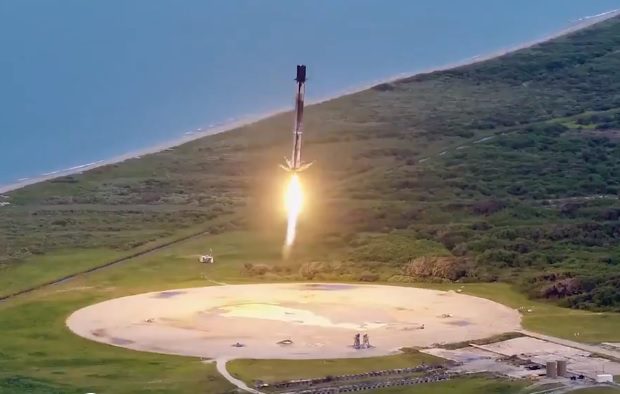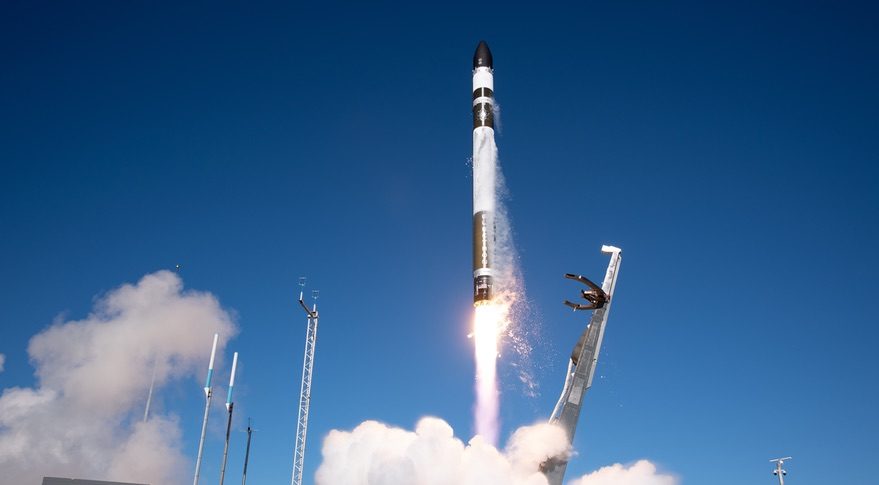Given that Vandenberg, California, is the main launch site for US missions to polar and near polar Sun-synchronous orbit launches, it was a surprise that SpaceX elected to use Cape Canaveral to launch Argentina’s second three metric ton radar satellite, SAOCOM-1B. Officially this was for reasons of SpaceX wanting to lower personnel at Vandenberg. The launch took place at 2318 GMT on 30 August 2020, making it the first polar launch from Cape Canaveral since 1969.
Once significantly clear of the coast, the rocket’s second stage made a dogleg turn towards a south westerly direction to achieve a circa 600 km Sun-synchronous orbit from where SAOCOM-1B was released for the Argentine space agency CONAE. The ground track of the latter part of the launch actually crossed Cuba.
In addition to its main payload, the launch also carried two small satellites. PlanetIQ’s GNOMES-1 uses radio signal-occultation for commercial weather/atmospheric measurement. The other satellite was a small technology test satellite called Tyvak-0172 carried for the manufacturer Tyvak. During the launch, the reusable Falcon 9 first stage (B1059 on its fourth flight) returned for a landing at Canaveral’s Landing Zone 1.
The SAOCOM-1B launch was expected to be the second of two Falcon 9 launches made in quick succession from the Cape. It was originally planned that a Starlink Falcon 9 launch would happen on the same day. However, due to a combination of delays to the Delta IV Heavy launch carrying the NRO L-44 mission having priority at the launch site, and weather issues, the 12th (11th fully operational) Starlink flight missed its launch window on 30 August.
The United Launch Alliance (ULA) operated Delta IV Heavy launch itself had even worse luck. Already delayed by a few days due to a ground systems pneumatics issue, the flight suffered an “abort” three seconds before its planned lift-off at 0604 GMT on 29 August with the already ignited main having to be shut down. The cause was later identified as an automated signal indicating a problem involving a high volumetric flow rate pressure regulator on a ground system which did not open. The scrubbed launch of the NRO L-44 mission, which is believed to be a Mentor-class signals intelligence satellite, has now been reset for 5 September.
When compared to Cape Canaveral, New Zealand’s Mahia peninsula is used much more often for polar launches. However, four hours after SpaceX at 0305 GMT on 31 August, an Electron launched to a non-polar 45 degree inclination 500 km low Earth orbit. This marks the return to flight for the Rocket Lab small launcher. On board was the Sequoia radar imaging satellite for Capella Space, which was originally planned to fly on the SpaceX launch of SAOCOM-1B but was moved due to schedule uncertainty.
Update on 4 September 2020: Rocket Lab has confirmed that this Electron launch did also carry First Light – a technology test satellite using its new Photon bus/platform made by modifying Electron’s kick stage. The idea is that Rocket Lab will eventually be able offer clients a turnkey satellite construction and delivery-to-orbit service.
The Electron is recovering from a launch failure two months ago. Which was traced to a power loss to the electrically-powered turbo-pump of the upper stage rocket after a connector became accidentally detached.
Matt Wilson contributed to this story
Launch times from Jonathan McDowell









